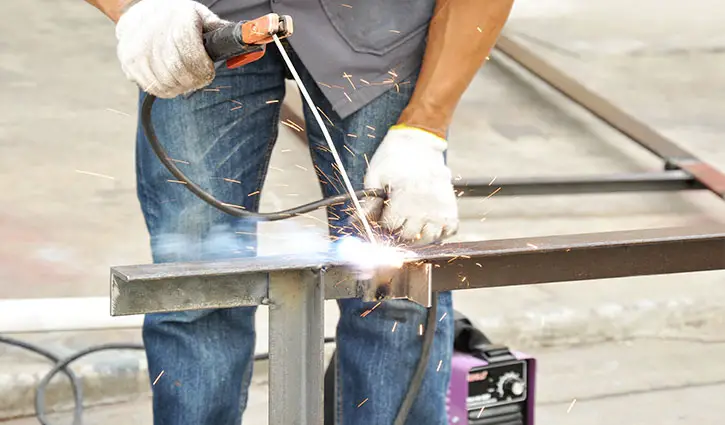Air Acetylene Torch Vs Oxy Acetylene: Features And Pros-Cons
Air acetylene torches are more popular than oxy-acetylene torches because they are cheaper to operate and use less gas.
An air acetylene torch uses a more miniature, lighter flamethrower that uses compressed air to ignite the acetylene gas. Oxy acetylene torches have a larger, heavier flamethrower that uses oxygen from the air to ignite the acetylene gas.
However, having knowledge of air acetylene torch vs oxy-acetylene will let you get the most suitable one. So, in this article, we are going to discuss an in-depth guide on air acetylene torch and oxy-acetylene.
Table of Contents
Comparison Table On Air acetylene torch and Oxy acetylene
| Torches | Air acetylene | Oxy acetylene |
| Cost | Less costly | Costly |
| Gas usage | Minimum | Maximum |
| Flame Throwing | Light | High |
| Fuel Efficiency | Longer | Less |
| Work with | Metal objects or weld joints | To create a hot flame |
| Heat Producing | Hooter but less heat | More Heat |
What is Air acetylene torch?
Air acetylene torches are less expensive to operate because they use less gas. The smaller, lighter flamethrower uses less gas to ignite the acetylene gas, which means the torch can run for a longer time before needing to be refueled.
Air acetylene torches are a popular choice for DIYers, as they are relatively easy to use and require little maintenance. Air acetylene torches are available in both handheld and stationary models and can be used to heat up metal objects or weld joints.
One of the main advantages of air acetylene torches is that they are light flame throwers.
Pros-cons of Air acetylene torches
There are many pros and cons to using air acetylene torches for welding. Have a look:
What is Oxy acetylene torch?
Oxy acetylene torches are one of the most common types of torches used in welding. They use a combination of oxygen and acetylene to produce a hot, Flame.
Read More: Types Of Welding Rods: Everything You Need To Know
Oxygen is used to create a hot flame, while acetylene is used to create the heat needed to weld. Oxygen is also used to start the flame, while acetylene is used to maintain the flame.
Pros-cons of Oxy acetylene torches
Oxy acetylene torches are extremely popular due to their many benefits. Here are some pros and cons.
Similarities between Air acetylene torch vs Oxy acetylene
Air acetylene torches and Oxy acetylene torches are often used in welding, as they have a higher heat output than air-powered torches.
They are also easier to use as the fuel and air supply are separate. Here are the core similarities between these two:
Transportation: Both Air acetylene torches and Oxy acetylene torches are portable and easy to use. It is safe to transport these torches according to your workplaces or projects.
Usability: Easy to use and beginner-friendly acetylene torches. But they can be dangerous if used incorrectly.
Difference between Air acetylene torches and Oxy acetylene torches
Air acetylene torch vs Oxy acetylene torch is always a food fight. However, both of these torches are very familiar to welders. There are several key differences between Air and Oxy Acetylene torches.
Air torches use a compressed air delivery system to create a high-velocity stream of air. This high-velocity air stream vaporizes the material being cut causing a hot, gas-fed flame to ignite.
And Oxy acetylene torches use a gas pedal and a trigger to create the same high-velocity air stream. Oxy acetylene torches use a hotter, more intense flame than air torches.
Air torches are less likely to cause a fire if the oxygen supply is cut off. Oxy acetylene torches will self-extinguish
Oxy acetylene torches are more powerful than air-powered torches and can be used for more difficult welding tasks.
Air acetylene torch vs Oxy acetylene torch: Which one should you choose?
Oxy acetylene torches offer a host of benefits when compared to air torches. Air torches are more commonly used in construction, as they are less expensive and more portable, but oxyacetylene torches have several advantages when it comes to welding and cutting.
For welding, oxy-acetylene torches produce a hotter flame that is more effective at welding metals. The hotter the flame, the better the weld. Oxyacetylene torches also have a longer runtime than air torches, which means they can be used to weld longer pieces of metal.
When it comes to cutting, oxy-acetylene torches are much more effective than air torches. The hotter the flame, the sharper the cutting blade.
FAQs
Yes, Air acetylene can be chosen for brazing.
For gas welding, a high flame temperature is needed. And acetylene is the best for producing high flame temperatures.
Oxygen is a less hot gas than acetylene. But it can produce much more heat than acetylene. Acetylene is hotter than oxygen but gives less heat.
Yes, oxy-acetylene gas is lighter than air.
Verdict
When it comes to choosing an air or oxy-acetylene torch, there are a few factors to consider.
The first is the size of the object you’re trying to torch. An air torch is smaller and more portable, while an oxy-acetylene torch is larger and more powerful.
The second is the type of safety. Air acetylene torches are less likely to cause a fire if the oxygen supply is cut off. Oxy acetylene torches will self-extinguish.
Read More: Can You Weld Aluminum With Flux Core? All You Need To Know!






